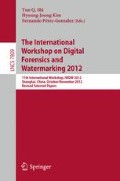Abstract
Electronic voice transformation with natural disguise ability is a common operation to change a person’s voice and conceal his or her identity, which can easily cheat human ears and automatic speaker recognition(ASR) systems and thus presents threaten to security. Till now, few efforts have been reported on detection of electronic transformation, which aims to distinguish disguised voices from original voices. Therefore in this paper we investigate the principle of electronic voice transformation, and propose a blind detection approach using MFCC(Mel Frequency Cepstrum Coefficients) as the acoustic features and VQ-SVM (Vector Quantization-Support Vector Machine) as the classification method. By extensive experiments, it is demonstrated to have classification accuracy higher than 98% in most cases, indicating that the proposed approach has good performance and can be used in forensic applications.
Access this chapter
Tax calculation will be finalised at checkout
Purchases are for personal use only
Preview
Unable to display preview. Download preview PDF.
References
Perrot, P., Aversano, G., Chollet, G.: Voice disguise and automatic detection: Review and perspectives. In: Stylianou, Y., Faundez-Zanuy, M., Esposito, A. (eds.) WNSP 2005. LNCS, vol. 4391, pp. 101–117. Springer, Heidelberg (2007)
Masthoff, H.: A report on voice disguise experiment. Forensice Linguistics 3(1), 160–167 (1996)
Laroche, J.: Time and Pitch Scale Modification of Audio Signals. In: Applications of Digital Signal Processing to Audio and Acoustics in the International Series in Engineering and Computer Science, vol. 437, ch. 7, pp. 279–309. Springer, US (2006)
McAulay, R., Quatieri, T.: Speech analysis/Synthesis based on a sinusoidal representation. IEEE Trans. on Acoustics, Speech and Signal Processing 34(4), 744–754 (1986)
Phase vocoder based voice transformation source code, http://www.dspdimension.com/smbPitchShift.cpp
Perrot, P., Chollet, G.: The question of disguised voice. The Journal of the Acoustical Society of America 123(5), 3878 (2008)
Künzel, H., Gonzalez-Rodriguez, J., Ortega-Garcia, J.: Effect of voice disguise on the performance of a forensic automatic speaker recoginition system. In: Proc. of Odyssey, pp. 153–156 (2004)
Reynolds, D., Rose, R.: Robust text-independent speaker identification using Gaussian mixture speaker models. IEEE Trans. Speech Audio Processing 3(1), 72–83 (1995)
Bonastre, J.-F., Matrouf, D., Fredouille, C.: Artificial impostor voice transformation effects on false acceptance rates. In: Proc. of Interspeech, pp. 2053–2056 (2007)
Matrouf, D., Bonastre, J.-F., Costa, J.P.: Effect of impostor speech transformation on automatic speaker recognition. In: Proc. of COST275 Workshop ”Biometric on the internet”, Hatfied, UK (2005)
Matrouf, D., Bonastre, J.-F., Fredouille, C.: Effect of voice transformation on impostor acceptance. In: Proc. of Int. Conf. on Acoustics, Speech, and Signal Processing, Toulouse, France (2006)
Linde, Y., Buzo, A., Gray, R.: An algorithm for vector quantizer design. IEEE Trans. Commun. 28, 84–94 (1980)
Libsvm Tool, http://www.csie.ntu.edu.tw/cjlin/libsvm
Campbell, W.M., Campbell, J., Reynolds, D.A., Torres-Carrasquillo, P.: Support vector machines for speaker and language recognition. Computer Speech and Language 20(2), 210–229 (2006)
Campbell, W.M., Singer, E., Torres-Carrasquillo, P.A., Reynolds, D.A.: Language recognition with support vector machines. In: Proc. Odyssey: The Speaker and Language Recognition Workshop, pp. 41–44 (2004)
TIMIT Acoustic-Phonetic Continuous Speech Corpus, http://www.ldc.upenn.edu/Catalog/CatalogEntry.jsp?catalogId=LDC93S1
Campbell, J.P., Shen, W., Campbell, W.M., Schwartz, R., Bonastre, J.-F., Matrouf, D.: Forensic speaker recognition. IEEE Signal Processing Magazine 26(2), 95–103 (2009)
Author information
Authors and Affiliations
Editor information
Editors and Affiliations
Rights and permissions
Copyright information
© 2013 Springer-Verlag Berlin Heidelberg
About this paper
Cite this paper
Wang, Y., Deng, Y., Wu, H., Huang, J. (2013). Blind Detection of Electronic Voice Transformation with Natural Disguise. In: Shi, Y.Q., Kim, HJ., Pérez-González, F. (eds) The International Workshop on Digital Forensics and Watermarking 2012. IWDW 2012. Lecture Notes in Computer Science, vol 7809. Springer, Berlin, Heidelberg. https://doi.org/10.1007/978-3-642-40099-5_28
Download citation
DOI: https://doi.org/10.1007/978-3-642-40099-5_28
Publisher Name: Springer, Berlin, Heidelberg
Print ISBN: 978-3-642-40098-8
Online ISBN: 978-3-642-40099-5
eBook Packages: Computer ScienceComputer Science (R0)

